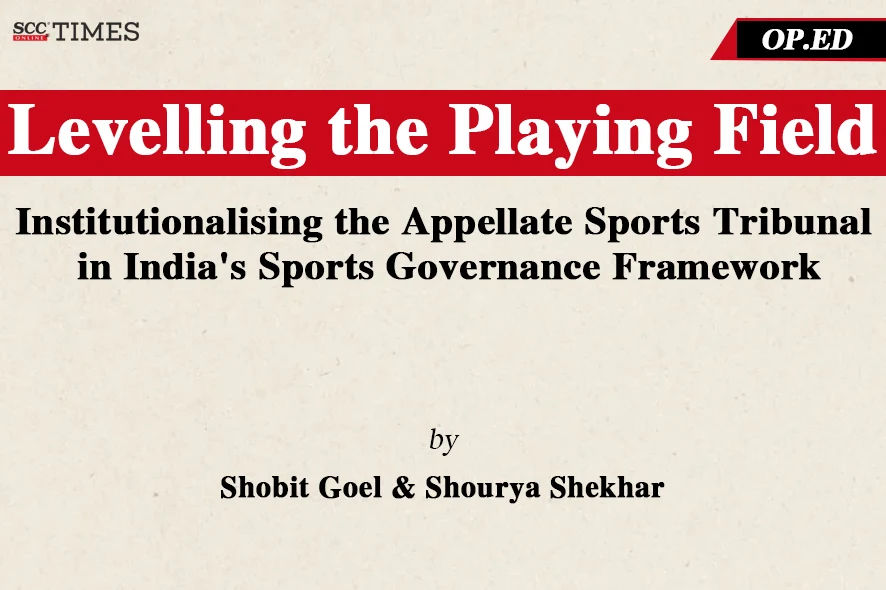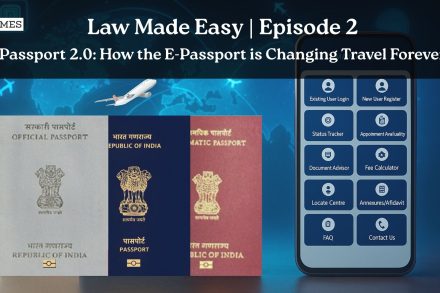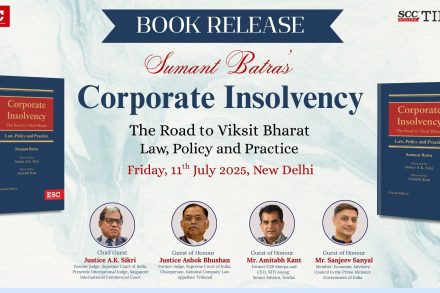Introduction
India as a nation has always resonated deeply with sports, with a massive reservoir of talent and a constantly growing presence on the international sporting stage. Unfortunately, this rise has yet to be matched with robust legal backing and governance structures. The National Sports Governance Act, 20251, is thus a significant step that attempts to address this gap, offering much-needed regulatory clarity and institutional support.2
The absence of a coherent dispute-resolution framework has plagued Indian sports and resulted in immense injustice for athletes. Over the past decade, Indian courts have witnessed nearly 770 sports-related cases, ranging from governance failures to team-selection grievances.3 However, courts have largely refrained from interfering in selection disputes, often deferring to sporting bodies under the implication that the idea of “who represents India is best left to the experts”.4 Due to the lack of an established forum, athletes have no choice but to seek judicial redress when the criterions are opaque or decisions seem arbitrary. This is further underscored by episodes like the Narsingh Yadav5 doping scandal and past International Olympic Committee (IOC) suspensions of the Indian Olympic Association (IOA) due to governmental interference. Currently, India lacks a specialised domestic adjudicatory body for sports disputes, with most cases being rerouted either through internal federation bodies or generalist courts. Only severe cases such as those pertaining to international doping or Olympic representation issues find relief through the international forum that is the Court of Arbitration for Sport (CAS). This issue is not one that has gone unnoticed, with the National Sports Governance Act, 2025 responding by proposing an Appellate Sports Tribunal (AST) under Chapter X to handle sports-related disputes.6 This essay aims to understand the proposed functioning of the AST and its dispute resolution mechanism and further aims to analyse how this body can support and provide a uniform structure that is the current need.
Gaps in current dispute resolution
The lack of a structured forum for dispute resolution has led to Indian courts becoming the de facto arbitrators for sports disputes, often to the detriment of the athletes and the federations. Of the various matters that still lay pending across High Courts and tribunals pan-India, over 200 involve National Sports Federations (NSFs) with roughly 150 pertaining to internal governance or election related matters and 64 referring to athlete-selection grievances.7 The reality of the situation shows a crisis perpetrated by deep systemic gaps; unclear rules, opaque selection policies and a lack of an independent forum to address such matters. The Delhi High Court’s recent order staying the Boxing Federation of India’s suspension of its office-bearers serves as an example of the very same. The High Courts have been witnessed to routine hearing of every multidiscipline game over selections and administration.
Why does such an impasse exist? Partly, because Indian athletes had no other forum to rely upon. National Federations’ internal appeal processes are weak or captive, and the National Sports Development Code, which formally recognised autonomy of NSFs, failed to provide any binding arbitration forum.8 With absence of any internal redress, athletes choose to move the courts through Articles 226/227 of the Constitution or regular Civil Procedure Code, 19089. Unfortunately, relief has not come easy as courts have been reluctant arbiters. The Delhi High Court held that it would not disturb the Wrestling Federation’s selection of Narsingh Yadav for the Rio Olympic Games, 2016.10 The Court placed emphasis on the point that selection decisions “are best left to the experts”, referring to the Federation. Similarly, the High Court also went on to dismiss a paralympic athlete’s appeal, reiterating their stance that courts should not interfere in a fair and transparent selection process.11 These instances clearly show judicial deference, but such deference proves to be a double-edged sword; in its validating of the autonomy of federations, it leaves aggrieved athletes without a swift remedy. The result is clear, with multiple lawsuits being prompted due to the same which drag on for years at end. The biggest gap in this arena of arbitration is the lack of an independent appellate body, akin to the CAS. Due to the lack of any structured arbitration framework, India’s anti-doping cases or international-level disputes simply default to the international fora. The Narsingh Yadav case is paradigmatic, after two positive tests in 2016, National Anti-Doping Agency (NADA)12 exonerated him on a “sabotage” theory, but World Anti-Doping Agency (WADA) appealed to the CAS ad hoc panel, which resulted in the panel setting aside NADA’s decision and imposing a four-year ban, thus nullifying India’s selection at the last hour.13 The fact that an Indian athlete’s fate was decided in Geneva rather than domestically showcases the need of the hour being a strong domestic tribunal.
Governance failures further exemplify the issue. The IOC has previously suspended the IOA twice in 2012 and 2014 due to alleged governmental interference and unconstitutional elections.14 IOA has also been a repeat offender of the “one person, one post” rule under Indian law. Lack of transparency while ignoring age verification rules, audited accounts and many such problems showcase the muddy waters Indian sports finds itself in. Without a unified tribunal empowered by statute, such disputes are bound to spill into ad hoc compromises and international embarrassment.
To put it simply, athletes and stakeholders lack a specialised, timely forum that has knowledge of sporting context. The Appellate Sports Tribunal to be established under the National Sports Governance Act, 2025 is explicitly meant to reduce the burden on courts by centralising sports disputes. Its envisaged role finds a model similar to that of CAS, aiming to inject expertise and finality.15 We must look into the Act’s details and omissions to determine whether the Tribunal truly fills these gaps.
Structure of AST
The AST, as provided under Chapter X of this Act, is a step towards joining other nations and becoming self-servient in its approach to sports.16 The Preamble of the Bill is very explicit in its wording when it mentions a need for resolution in a unified, equitable, and effective manner, and that is exactly what the AST aims to do.17
What we first need to understand is, that Chapter X currently is a bare provision; it lays down the broad structure of the Tribunal, but most powers are still left for the centre to prescribe. The Chapter starts by establishing the Tribunal, where the majority of the work is left to the Central Government to propose and finalise. Section 26(3) mandates that the selection of the AST must be made on the recommendation of a committee comprising18:
(i) Retired Supreme Court/High Court Judge — who shall be the Chairperson;
(ii) Secretary, Department of Sports — Member ex-officio;
(iii) Secretary (Law) or his/her nominee — Member ex-officio.
Section 27 of the Act further prescribes that the AST has exclusive jurisdiction on matters mentioned in the National Sports Governance Act, 202519, while the same does not provide for what matters the AST should adjudicate, it does provide an exclusion clause, excluding only 2 aspects20:
(a) Any matter or dispute arising during Olympic Games, Paralympic Games or similar events organised by international federations and any other matter of which the CAS has exclusive jurisdiction.
(b) Anti-doping matters where the National Anti-Doping Act, 202521 provides exclusive jurisdiction to the disciplinary panel.
The Tribunal aims to provide for a uniform dispute-resolution mechanism, spearheaded by legal luminaries as well as sports administrators so to have a balance of both legal and sports perspectives. The Bill further recognises the delays and long process for such disputes and under Section 2922, grants the power to transfer all pending cases where the (NOC), (NPC), NSF have been impleaded as a party to be transferred to the AST and be adjudicated from the stage it was pending, this underscores the Bills aim to provide speedy and fair resolution of disputes.23
The Bill further provides that the AST should function like a civil court as prescribed under the Civil Procedure Code, 1908. It also provides the powers, including but not limited to summoning, discovery and production of documents, reviewing its decisions. It also provides a mechanism to appeal its order (other than an interlocutory order) to the Supreme Court as rests with any civil court under Section 100 of the Civil Procedure Code, 1908, within a maximum of 30 days from the decision of the AST.24
While the Bill provides for a lot of hope for a uniform structure, what remains to be seen is its execution. The Bill by its dispute resolution, aims to be a domestic CAS.
Global Sports Tribunal Models
India has traditionally adopted formal legal structures later than Western counterparts and is seen to be borrowed from the same, this was seen more recently with the Digital Personal Data Protection (DPDP)25 and the General Data Protection Regulation (GDPR)26, however, the same lacks with the AST.
The concept of Sports Tribunals is a growing one in today’s time, while most countries like the UK, may go through this with the help of a privately administered body without any direct State control, some like Australia may have only recently introduced a codified legislation of the same. With these comparisons our aim is to analyse the framework in other jurisdictions of this one-stop forum to fill any gaps or issues with effectiveness in the present proposal.
One of the earliest instances of a Sports Tribunal was the Sport Resolution (SR), a not-for-profit arbitration and mediation centre established in 1977.27 While the SR has no statutory backing, it was setup by 9 bodies including the British Olympic Association and has been as a staple in the nation with it being routinely added in rules relating to sports bodies. One thing that the SR brings its specialised panel to cater to all kinds of disputes, the panel is chosen from a pool of legal members, which includes retired Judges/lawyers and specialist members like former athletes and specialised doctors.28 Similarly, the USA also does not have any National Sports Tribunal and all disputes are handled through private arbitration, which derives its authority from collective contracts and not statutes.29
Australia on the other hand has recently established its National Sports Tribunal (NST) by federal law in 2019. The NST is an independent commonwealth body funded by the Government.30 The Tribunal aims to bring an effective, efficient and specialised tribunal for resolution of ports disputes by handling matters like anti-doping, team-selection and eligibility. The recent case, where the NST upheld an athlete’s doping ban under anti-doping rules showcases the growth of the Tribunal, previously all such cases would have been transferred to CAS.31 However, the NST does not have universal jurisdiction like the AST and can only hear matters where there is an internal appeal route in the sports rules and no other forum applies. Moreover, Australian players can appeal only to the NST and cannot sue directly in ordinary courts.
Lastly similar to the NST, Canada through its Physical Activity and Sport Act of 200332 established the Sport Dispute Resolution Centre of Canada (SDRCC).33 The SDRCC is a non-profit organisation and funded by Sports Canada to provide arbitration to disputes of anti-doping, team-selection/eligibility matters. For e.g. when a Canadian athlete is found in violation of an anti-doping rule by their federation or by the Canadian Centre for Ethics in Sport (CCES), the athlete can appeal to the SDRCC’s Doping Tribunal. Similarly, disputes like Olympic team selection or carding (funding) eligibility go to the SDRCC’s review panels.34
While it is clear that Sports Tribunals differ from jurisdiction to jurisdiction, the Indian AST differs from these in various important ways. The AST is a statutory, mandatory and Government funded one-stop court of appeals for all sports disputes in India. The AST also has broad coverage with civil court powers whereas, the UK and USA are more voluntary in nature, and the Canadian SDRCC mainly covers amateur and anti-doping. While the main purpose of the AST is to reduce court intervention and essentially oust the traditional courts for these disputes, this is not resonated with other jurisdictions like the USA where the athletes still resort to courts if needed.
While this may seem to be in-line with global trends, the same may not be seen from other perspectives, like sports federations that would lose autonomy and even internal selection appeals would go straight to the AST, similarly the national governance bodies like the NSF, NOC would have AST to enforce standards. While these may turn out to be a short straw in the long run, the AST takes the specialist focus of CAS/NST/SDRCC but embeds it in statutory law like a court and if enacted, India’s AST would become that final arbiter within India, shaping the landscape of sports law and affecting athletes, federations, and sport governance by unifying dispute resolution under one roof.
Doctrinal analysis of the AST
The AST is a huge leap in the right direction for Indian sports governance, but to ensure true pan-India relief to even grassroot level athletes, it is imperative to ensure the gaps that persist be looked into.
The AST provides an all-encompassing structure and complete compliance with International Sports Law and as seen above, it provides for an exclusion of cases pertaining to doping which are covered by the National Anti-Doping Act’s panels, thus ensuring that there is no statutory overlap.
While these exclusions do serve their purpose in preventing legal conflicts, they also remove high-stakes arenas from the Tribunal’s jurisdiction. The Narsingh Yadav case clearly outlines the issue as India could do nothing but allow the doping appeals to be tried abroad. Indian sports will still unfortunately have to rely on CAS and NADA for a big slice of issues. If a fully “unified” system be put into place, it may at least channel doping appeals into the Tribunal while ensuring WADA compliance safeguards or may even empower the Tribunal to review domestic anti-doping panel awards, subject to international obligations.
Another jurisdictional question that we must pay heed to is “What Constitutes a Sports Dispute?”. The NST experience serves as a warning that vague phrasing such as this can further create uncertainty.35 The Act does not clearly define “sports grievance” or “sports dispute” at any stage and relies on federation constitutions and the Bill’s objectives. Is a contractual dispute relating to sponsorship or a stadium’s lease within the AST’s domain or should it stay within the civil courts? International Sports Codes must be complied with in order to prevent this and categories such as election challenges, disciplinary appeals, contract disputes between athletes and federations, etc. must be adopted. Thus, the Act’s open wording must be tightened through stringent regulation.
Further, Clause 26(3) ends up making the Selection Committee largely governmental as the Sports Secretary and Law Secretary join a retired Judge chair.36 The Central Government then appoints members based on their recommendations. This inclusion of executive officers is another red flag as it raises independence concerns. Unlike its Australian contemporary, the NST, where judicial or bipartisan appointments might feature, India’s proposal simply gives into the hand of executive influence. The protections enshrined in Section 34(2) which require the CJI’s referral for removal of members, mirror judicial security but it is the phase of appointment that still remains opaque.37 The addition of judicial or parliamentary members would be in furtherance of strengthening such independence. India should consider formally involving a sports law panel, or independent commission in selecting AST members, rather than sole Government discretion.38
Further, it is understood that the AST will have same powers as a civil court. Its orders are executable as civil decrees and it follows the model of tribunals in India. However, the Bill noticeably lacks procedural safeguards. There is no discourse or guidelines provided regarding mandated timelines for adjudication, along with vague and open-ended language regarding rules for evidence or hearings. In sports disputes, the timeliness of decisions in matters pertaining to selection or disciplinary appeals can be crucial. The Act does not impose strict time-limits beyond the use of the term “expeditious procedure”.39 Prescribing short notice periods, evidence schedules and limited appeals are just some of the ways the process can be streamlined effectively. The rules for the Act must also detail out seat, venue, timeline for submission and virtual hearing options in sports arbitration disputes.40
The Tribunal is still quite doctrinally sound as a specialised civil court, but its implementation details are critical. Athletes will no longer be able to take their disputes to courts and must first use the AST, which reinforces the need for it to be accessible and fair, as it is a mandatory forum.
Recommendations and global best practices
To realise its promise, the AST should further be strengthened by reforms informed by global practices and legal principles. The first step in this direction is to inculcate a transparent appointment process with experience in sports law and arbitration expertise being some of the parameters for member selection. Inspiration can also be taken from the UK’s Sports Resolutions which uses closed lists of approved arbitrators with fixed terms. India can also be privy to publishing such a list of eligible candidates while at the bare minimum, requiring publication of member nominations and opportunity for objections, to build confidence in neutrality. Further, to minimise executive sway, perhaps inclusion of a representative of the National Human Rights Commission, which has sports under its remit could balance the Sports Secretary’s role. Given the CJI’s involvement in removals, it would be logical to involve the judiciary earlier, as is done with Judicial Appointments Commission. Inclusion of a nominee of the Chief Justice of India would serve in furtherance of the same.
The absence of deadlines is another major gap which ought to be remedied. The Bill, or its subordinate rules, should set out firm timelines, such as initial hearing within 30 days of filing and final award being declared within 90-120 days with short extensions only for exceptional reasons. International sports arbitration is a cornerstone of expediency, with CAS imposing strict and tight schedules. The very right to timely justice must be ensured for athletes and the same would be in line with Article 21 of the Indian Constitution.41
Further, the publication of reasoned awards, at least in anonymised form while keeping the proceedings confidential would provide a huge leap in the understanding of arbitral awards in sports pan-India. Anonymised summaries or redacted versions of arbitration decisions being published also serves to promote transparency, while creating jurisprudence and allowing stakeholders to learn from rulings. A similar example can be seen in the UK’s Sports Resolutions, which publishes case digests without personal data to illustrate outcomes. Indian courts have also been privy to the same, with service and Consumer Tribunal decisions being published increasingly to bolster consistency. The legitimacy of the AST will only be strengthened if it follows in the footsteps of its global predecessors.
We must also pay heed to the huge gap left by the exclusion of various arenas from the AST’s jurisdiction. The Parliament could consider at least partial inclusion of doping appeals or Olympic disputes into the AST. For instance, the Tribunal may be empowered to hear appeals from NADA panel decisions, even if a further appeal goes to CAS, or to entertain disputes tied to selection for international games while being subject to IOC norms. Careful treaty compliance with the Olympic Charter is imperative throughout this process. To further align the AST with global standards, membership of arbitrators on global panels along with use of the IOC’s Model Arbitration Regulations for the Olympics can serve as the first few stepping stones.
Finally, the Act is unfortunately silent on interlocutory reliefs or injunctions. In practice, aggrieved athletes often seek urgent stays and the AST must possess the explicit power to grant interim measures pending final hearing. The powers must mirror those under Order 39 of the Civil Procedure Code, 190842 or Section 9 of the Arbitration and Conciliation Act, 1996 to allow emergency relief.,43 This would simply prevent drift to civil courts for interim help, as is currently the norm. At the end, India’s athletes deserve a domestic tribunal that is on par with global standards.
The above analysis underscores that meaningful reform of the Appellate Sports Tribunal must address fundamental structural and procedural flaws. Chief among these is the opaque appointment process and attendant executive domination. As currently constituted, the Selection Committee skews heavily towards the executive, inviting concerns about Tribunal independence. Such executive control; compounded by broad removal powers exercisable on nebulous “public interest” grounds undermines the separation of powers and compromises the impartiality expected of a quasi-judicial body. Additionally, the AST’s jurisdictional carve-outs leave significant gaps. By excluding critical matters like doping violations and internal selection disputes, the framework denies aggrieved athletes a forum for some of the most consequential grievances. This ambiguity not only breeds litigation over the Tribunal’s remit but also risks forcing athletes back to the High Courts. Equally problematic is the absence of any provision for interim relief or expedited procedure. Without interim powers, the athletes must still rush to civil courts for urgent injunctions; defeating the very purpose of a specialised Sports Tribunal. Likewise, the lack of statutory timelines foreshadows procedural delays, and the silence on publishing awards perpetuates opacity in sports adjudication.
The reforms put forth tackle these very deficiencies with a multi-pronged approach grounded in comparative best practices and constitutional principles. To cure the opaque and executive-driven appointments, a transparent and merit-based selection process is imperative. This means instituting an independent search-cum-Selection Committee where the judiciary holds a clear majority or casting vote, as the Supreme Court has mandated for tribunals. For example, the Committee could be chaired by the Chief Justice of India, or a nominee and could include representatives from outside the executive, such as the National Human Rights Commission and athlete ombudsmen, alongside government officials. All vacancies should be publicly notified and nominations disclosed, allowing for scrutiny of candidates’ credentials. Fixed tenure protections must accompany this process to cement independence. A single non-renewable fixed term must be set out for AST members, with removal only through a robust procedure rather than at the executive’s whim.
Secondly, statutory deadlines for dispute resolution are needed to prevent delay. Drawing inspiration from international sports arbitration, the AST’s proceedings must be time-bound. A provision could be set out mandating that:
9.(2) The Tribunal shall commence hearings within 30 days of the appeal and render a final award within 90 days of the first hearing, extendable by a single 30-day period for recording purposes.44
This mirrors the CAS Code, which requires panels to communicate operative awards within a fixed time-frame. Embedding such timelines in the Act instead of leaving them to the Tribunal’s discretion would not only expedite justice but also align India’s sports dispute resolution with global standards of swiftness.
Further, the AST’s jurisdiction must be broadened to eliminate current exclusions that thwart comprehensive sports justice. We must strive towards an arena of sports jurisprudence wherein an athlete sanctioned by NADA could appeal to the AST, before any recourse to the CAS. This is consistent with WADA’s framework, which envisions national appeals where available. The AST’s decisions would of course honour substantive WADA rules and allow an ultimate appeal to CAS by WADA or international bodies, thereby respecting India’s international obligations while still affording domestic due process.
Similarly, selection and eligibility cases, especially for the Olympics and other major events should be explicitly included in the Tribunal’s scope. A model clause could be drafted along such lines:
“Any dispute concerning the selection or non-selection of an athlete for international competition shall be justiciable by the Tribunal, notwithstanding internal federation decisions, subject only to the final authority of international sporting bodies under the Olympic Charter.”
By bringing these sensitive matters under the AST, athletes gain a specialised forum for urgent relief, reducing the reflex to invoke writ jurisdiction on the eve of competitions. Of equal importance is injecting transparency into the AST’s functioning. To build a repository of lex sportiva and enhance accountability, the Act should require that all final awards of the Tribunal be published in a timely manner, with appropriate anonymisation of personal data. Notably, international practice leans towards openness, with CAS routinely releasing awards or summaries publicly be default and Sports Resolutions UK similarly publishing arbitral decisions unless confidentiality is expressly sought. An Indian statutory rule could thus mandate that:
“Every award of the Appellate Sports Tribunal shall be made available on a public website within 30 days, omitting identifying details as necessary to protect privacy.”
This would further enlighten stakeholders on the reasoning behind decisions, promote consistency in future rulings and bolster confidence in the system. Finally, the reforms must equip the AST with interim relief powers akin to those of civil courts and Arbitral Tribunals. The Act should vest the Tribunal with authority to grant urgent measures on the lines of Order 39 of the Civil Procedure Code, 1908 and Section 9 of the Arbitration and Conciliation Act, 1996.45 The provision could state that:
“The Tribunal may pass interim orders, including injunctions or other protective measures, as it deems fit in the interest of justice during the pendency of a dispute.”
Such a clause would enable the AST to rapidly address irreparable harm scenarios, without forcing recourse to external courts. In turn, this would give full functional credence to the bar on civil court jurisdiction by filling the remedial gaps that currently exist.
The envisioned form of the AST is unmistakably multidimensional, spanning the Tribunal’s composition, procedure, reach and output. Each measure complements the other in forging a tribunal that is independent, efficient, inclusive in jurisdiction and transparent. Crucially, these reforms respond to the lived reality of sports disputes in India, where over 350 cases are languishing in various courts on matters of selection, election, and discipline, to the detriment of athletes’ careers. A reconstituted AST with expedited timelines, interim powers, and broad coverage can decisively unclog this block and offer athletes a one-stop forum that is faster and more expert than conventional litigation. Constitutionally, the reforms hew to the principles laid down by the higher judiciary; ensuring judicial primacy and independence in tribunal appointments is essential to satisfy the separation of powers doctrine and to preserve the adjudicatory fairness guaranteed by Articles 14 and 21 of the Constitution46. In effect, the proposals strive to future-proof the AST against the fate of other tribunals struck down for want of independence or efficacy. By adopting transparent appointment processes, enforceable timelines, expanded interim relief powers, the National Sports Governance Framework would realise a balanced and forward-looking sports dispute resolution mechanism. Such addendums not only advance the cause of sports justice for athletes and federations, but also fortify the Act’s legitimacy in the eyes of constitutional courts. The reform is a holistic effort to truly achieve the mission of the AST in giving wings to India’s aspirations in sports, grounded in the rule of law and best practices of global sports governance.
Conclusion
The currently proposed AST represents a watershed shift in Indian sports law. By unifying sports disputes under one specialised forum, the Act aspires to end the staggering number of court cases in sports and to protect the integrity of competitions. Its framework provides a robust foundation yet at the moment, the Tribunal’s effectiveness will hinge on certain details. Member selection, procedural rules and support mechanisms are some of the arenas which require further discussions and clarity. To truly revolutionise Indian sports governance, the Tribunal must be independent, athlete-friendly and efficient. Achieving this first and foremost requires plugging the aforementioned gaps.
Comparative law clearly shows that no system is perfect. UK’s Sports Resolutions shows the value of expertise and neutrality while Australia’s NST highlights the need for a clear mandate and funding. The US model further underlines the importance of statutory authority and specialist administration. The Indian AST can learn from each of these, while tailoring itself for local needs. Crucially, credible legal backing, proper funding, open appointments and published jurisprudence will earn the trust of stakeholders in the Tribunal’s decisions. Sports arbitration in India must move towards certainty, fairness and transparency. If these principals guide its final shape, the Appellate Sports Tribunal can fulfil its promise as a guardian of fair play; on and off the field.
*3rd year student, BA LLB (Hons.), National Law University Jodhpur. Author can be reached at: shobitgoel224@gmail.com.
**3rd year student, BA LLB (Hons.), National Law University Jodhpur. Author can be reached at: shouryas19@gmail.com.
1. National Sports Governance Act, 2025.
2. National Sports Governance Bill, 2024 (Draft Bill, Ministry of Youth Affairs and Sports, Government of India, 10-10-2024).
3. Mihir Vasavda, “Factional Fights, Aggrieved Athletes: In 10 Years, About 770 Sports Cases in Court, 200-Plus Governance Related”, The Indian Express (The Indian Express, 17-3-2025).
4. Sushil Kumar Sharma v. Union of India, (2005) 6 SCC 281.
5. “Wrestler Narsingh Yadav Given Four-Year Doping Ban After WADA Appeal”, Reuters (Rio de Janeiro, 18-8-2016).
6. National Sports Governance Bill, 2025, Ch. X Ss. 27-29.
7. Mihir Vasavda, “Factional Fights, Aggrieved Athletes: In 10 Years, About 770 Sports Cases in Court; 200-Plus Governance Related”, The Indian Express (The Indian Express, 17-3-2025).
8. National Sports Development Code of India 2011 (Ministry of Youth Affairs and Sports, Government of India, 31-1-2011).
9. Constitution of India, Arts. 226-227; Civil Procedure Code, 1908.
10. Sushil Kumar v. Union of India, 2016 SCC OnLine Del 3660.
11. Karamjyoti v. Union of India, 2016 SCC OnLine Del 6766.
12. National Anti-Doping Agency (NADA) (31-12-2008).
13. “Wrestler Narsingh Yadav Given Four-Year Doping Ban After WADA Appeal”, Reuters (Rio de Janeiro, 18-8-2016).
14. Sport Resolutions, “Indian Olympic Association Rejects New Draft of its National Sports Code Amidst Fear of IOC Suspension”, Sport Resolutions (12-11-2019).
15. Krishnan Sreekumar, “A New Era in Sports: Analysing the Draft National Sports Governance Bill 2024”, KSandK (30-10-2024).
16. National Sports Governance Bill, 2025, Ch. X Ss. 27-29.
17. National Sports Governance Bill, 2025, Preamble.
18. National Sports Governance Bill, 2025, S. 26(3).
19. National Sports Governance Bill, 2025, S. 27.
20. Andrew Amsan, “No More Going to Court Over Selection or Sports Administration Matters If Govt. Bill Becomes Law”, The Indian Express (The Indian Express,2 August 2025)
21. National Anti-Doping (Amendment) Act, 2025.
22. National Sports Governance Bill, 2025, S. 28.
23. Krishnan Sreekumar, “A New Era in Sports: Analysing the Draft National Sports Governance Bill 2024”, KSandK (30-10-2024).
24. Civil Procedure Code, 1908, S. 100.
25. Digital Personal Data Protection Act, 2023.
26. Regulation (EU) 2016/679 of the European Parliament and of the Council (27-4-2016).
27. Sport Resolutions, “Our History”, Sport Resolutions (1997).
28. Sport Resolutions, “Our History”, Sport Resolutions (1997).
29. Dana Baiocco, “Sports Arbitration: A Case Study from the USA (Bad Bunny and MLBPA Sanctions)”, Clyde & Co Insights (11-7-2024).
30. Jeremy Moller and James Higby, “Two Years Not-Out: Assessing the Australian National Sports Tribunal”, Norton Rose Fulbright — Inside Sports Law (9-5-2022).
31. Jeremy Moller and James Higby, “Two Years Not-Out: Assessing the Australian National Sports Tribunal”, Norton Rose Fulbright — Inside Sports Law (9-5-2022).
32. Physical Activity and Sport Act, 2003 (Canada)
33. SDRCC, “Our History” Sport Dispute Resolution Centre of Canada (March 2003).
34. SDRCC, “Our History” Sport Dispute Resolution Centre of Canada (March 2003).
35. Jeremy Moller and James Higby, “Two Years Not-Out: Assessing the Australian National Sports Tribunal”, Norton Rose Fulbright — Inside Sports Law (9-5-2022).
36. National Sports Governance Bill, 2025, S. 26(3). (not found) (bill or act which reference will go, not clear please check)
37. National Sports Governance Bill, 2025, S. 34(2).
38. Mihir Vasavda, “No More Going to Court over Selection or Sports Administration Matters, If Govt. Bill becomes Law”, The Indian Express (Indian Express, 14 October, 2024).
39. National Sports Governance Bill 2025, S. 26(2)(c). (bill or act which reference will go, not clear please check, (2)(c) not found)
40. Mihir Vasavda, “No More Going to Court over Selection or Sports Administration Matters, If Govt. Bill becomes Law”, The Indian Express (Indian Express, 14 October, 2024).
41. Constitution of India, Art. 21.
42. Civil Procedure Code, 1908, Or. 39.
43. Arbitration and Conciliation Act, 1996, S. 9.
44. Arbitration and Conciliation Act, 1996, S. 9(2).
45. Civil Procedure Code, 1908, Or. 39; Arbitration and Conciliation Act, 1996, S. 9.







